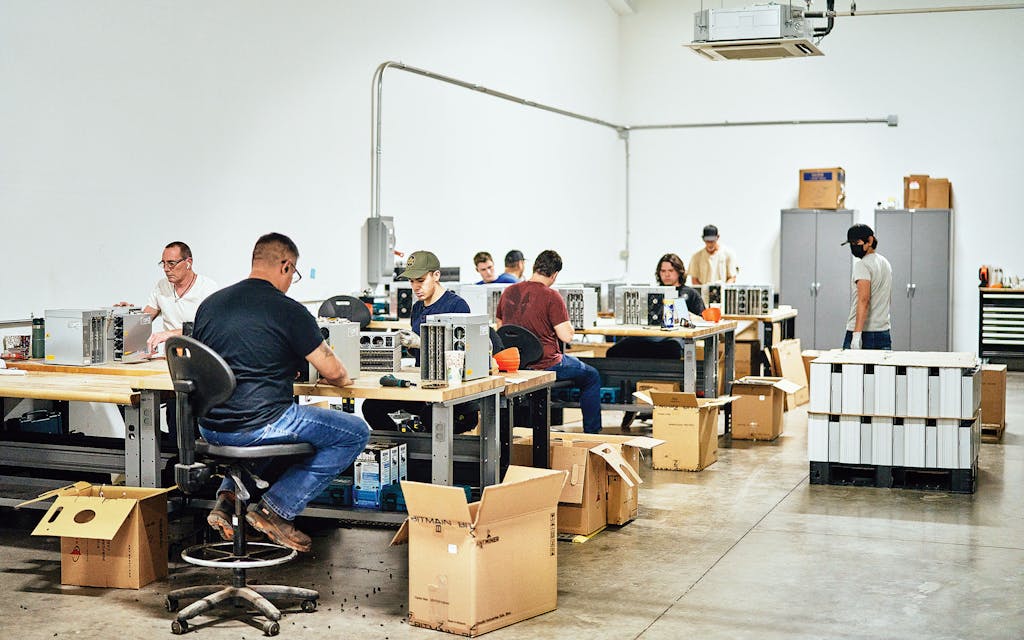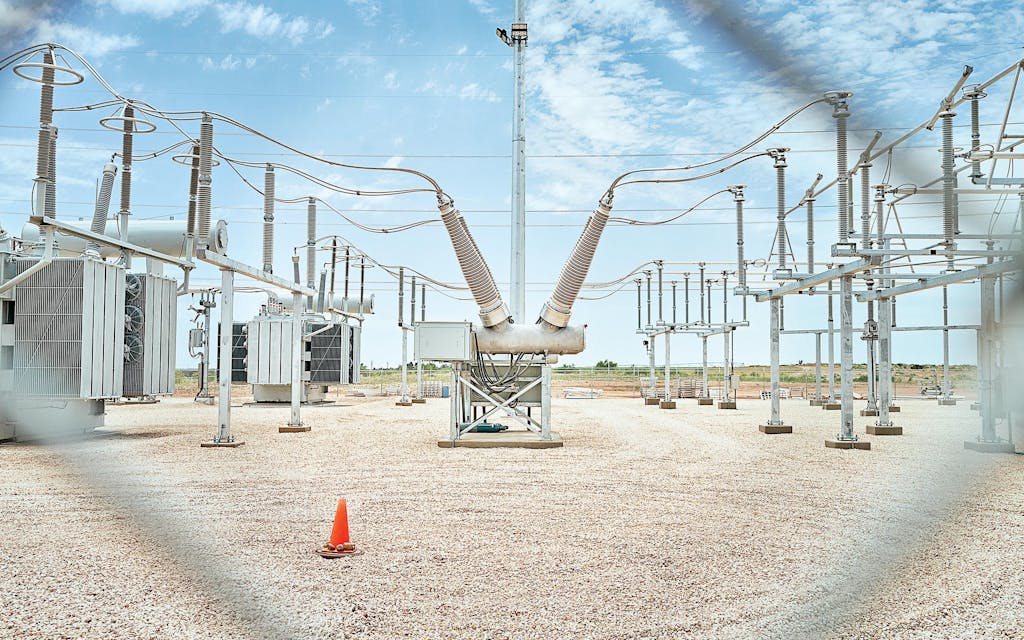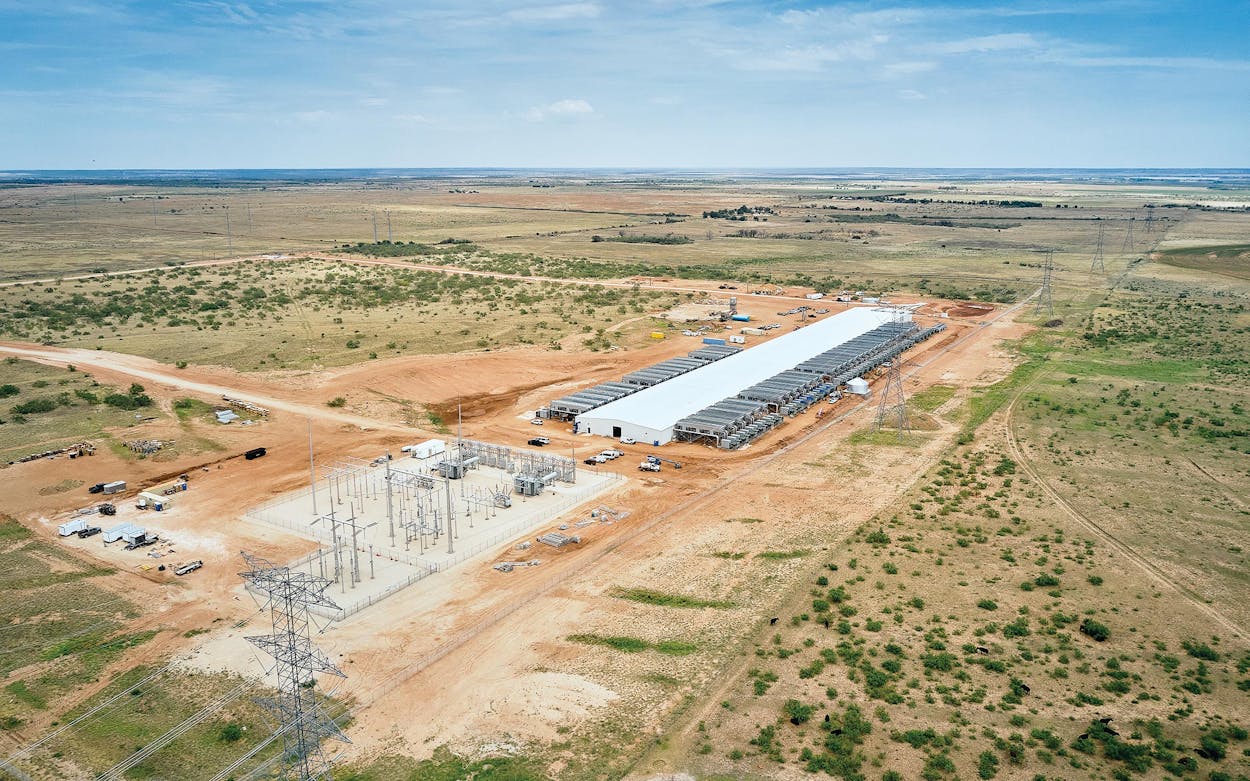Thick drops of rain thwacked the windshield as I neared a massive new cryptocurrency mine named for Helios, the mythological Greek god of the sun. The heaviest precipitation in months for the area—an hour east of Lubbock—had turned the red-dirt road into slippery muck. Within sight of the facility, it became clear my car could go no farther.
An eighteen-wheel tractor trailer delivering pallets of computer servers had jackknifed, blocking the road. I watched for several minutes before a forklift managed to free the truck with help from a thick chain. The forklift’s operator whooped and handed out enthusiastic fist bumps to several nearby Helios workers.
Lane Kingsbery, the mine’s operations manager, arrived in an electric cart to ferry me across the mud. But his vehicle soon began to run out of juice, slowing to a crawl. We reached the building with the cart’s battery fully drained. Ironically, in a place that pulls more electricity from the power grid than some Texas cities, someone must have forgotten to charge the cart. And the muddy road remained unpaved because it was a lower priority for the construction crews than finishing the 1,050-foot-long, white, one-story structure to get the mine—actually a specialized data center—operational as quickly as possible.
Cryptocurrency mining is a race. To earn Bitcoin, Helios must run mind-boggling numbers of calculations to solve a mathematical problem. The solution is a unique string of numbers and letters—like an incredibly strong password—designed to keep each Bitcoin transaction secure on a digital ledger known as the blockchain. Miners are rewarded for the computational power they’re lending to this effort.
The first to the solution gets a little more than six bitcoins, worth about $425,000 at the currency’s all-time peak last November, but only about $120,000 as of early July. By the end of the year, Helios plans to have 50,000 servers executing nearly four quintillion calculations—that’s four billion billions—every second. How much that will yield depends on many variables, especially the number of competitors operating, but Helios conservatively expects to generate more than one thousand bitcoins per year.
Bitcoin, the first widely adopted and still the best-known digital currency, has been around since 2009, when it was created during the global economic recession as a means of bypassing traditional financial institutions. Early crypto enthusiasts set up computers in garages to mine coins. By late 2017, Bitcoin’s rising value and popularity begat large-scale operations—warehouse-size data centers filled with servers.

Running thousands of these mining “rigs”—stripped-down, specialized computers—generates heat, which must be controlled lest the servers shut down or even catch fire. Considerable power is needed to operate and cool the machines. Mines vary in size, but some consume about as much electricity as a midsize city. Consequently, miners began to seek locations with abundant, relatively inexpensive electricity.
They set up in places such as Quebec, Canada, which has plentiful hydroelectric power. But so many mine operators asked to plug into the province’s grid that regulators, in 2018, instructed the local utility to temporarily stop powering new mines. A Chinese company opened Texas’s first large-scale crypto mine the next year, in a former aluminum smelter in the central Texas town of Rockdale. Most new mines at the time were popping up in China, but last year, that country’s government announced it would cut off power to miners. Among other concerns, China worried that burning fossil fuels—mainly coal—to power the mines was undermining its climate and pollution-reduction goals.
Miners started flocking to Texas, and the state is now an emerging global center for cryptocurrency. Reliable figures are difficult to come by, but an industry advocacy association in the state estimates that 9 percent of the computing power worldwide that is used to create new Bitcoin and other digital currencies is in Texas, and the number is expected to reach 20 percent by the end of next year. A Cambridge University index, meanwhile, pegged the level at 4.2 percent at the end of 2021.
Peter Wall, 47, the chief executive of Argo Blockchain, the London-
based company building Helios, called his facility’s location in Dickens County “Bitcoin mining nirvana.” The Canadian former video journalist, who sports a small soul patch and spiky white hair, said Argo chose the area because it offers plenty of inexpensive acreage and some of the lowest electricity prices in the state, thanks to an abundance of nearby wind farms.
Construction of Helios began in July 2021, and it took nine months to turn a cow pasture into one of the state’s largest crypto mines. So much high-strength concrete was required for its foundation that Argo set up its own concrete plant on-site. The values of cryptocurrencies—and Argo’s share price—have fallen sharply since November, but Helios is moving ahead. Wall said the company’s approach is to weather the ups and downs of the volatile crypto market, to keep mining and “hold on for dear life,” or HODL, an acronym beloved by crypto enthusiasts.


State and industry officials believe Helios is one of about ten large-scale mines in Texas. By the end of this year, Helios expects to draw 200 megawatts around the clock. Last summer, Lubbock’s usage reached as high as 444 megawatts. College Station used 213 megawatts. Texas’s main grid operator, the Electric Reliability Council of Texas, or ERCOT, says prospective crypto mines have applied to connect and draw about 20 gigawatts—or 20,000 megawatts—of power. That’s roughly equal to the amount of electricity used by the Houston metropolitan area on the hottest days.
Not all of those twenty gigawatts’ worth of mines are likely to be built, but facilities using two gigawatts are up and running. Both ERCOT and industry groups believe crypto mines will consume as much as five gigawatts by the end of 2023. However, rising electricity prices and the falling value of cryptocurrency could dent that expansion.
ERCOT manages a power grid that is struggling. In February 2021, it was infamously crippled by widespread blackouts during an Arctic blast that other states managed to weather without much disruption—and without the estimated seven hundred fatalities suffered in Texas. Earlier this year, six fossil-fuel plants unexpectedly shut down, turning off 2,900 megawatts of grid capacity and prompting a statewide call for conservation at a time when temperatures topped 90 degrees.
So, why is Texas even considering adding a new Houston of electricity demand over the next few years? The answer may lie in another major energy shift playing out in the state—the ongoing solar power boom.
Outside Bogata, a small East Texas town about a two-hour drive northeast of Dallas, the Chicago-based renewable energy firm Invenergy is building the country’s largest solar power plant. Several fields are covered with rows of dark panels that follow the sun throughout the day. Nearby are fields of wildflowers the company plans to cover with thousands of additional panels. When complete in 2024, the $1.6 billion Samson Solar Energy Center will spread across 18,000 acres and be capable of generating 1,310 megawatts of electricity. That’s about half the output of either of Texas’s nuclear power plants.
This solar farm and dozens of others across Texas are being built largely because more and more blue-chip corporations have pledged to slash their carbon emissions. AT&T, Google, Home Depot, Honda, and McDonald’s have contracted to purchase most of Samson’s electricity. While the companies may rely on gas or coal to power their stores, factories, and data centers, they plan to offset this consumption by supporting this new solar-powered electricity in East Texas. Because business-friendly regulators make it relatively easy to build new power plants here, Texas has become the prime destination for corporate-driven solar projects—much as it has for cryptocurrency mines.
As a result, there is often more renewable electricity produced than the grid can physically accommodate. Sometimes, for example, there is a surplus in West Texas that can’t reach the state’s major metros because of a dearth of high-voltage wires to get it there. At extreme levels, a glut of supply can jeopardize the grid’s stability, much as not having enough available power does. There’s a risk of collapse that could even lead to blackouts. So ERCOT regularly instructs renewable energy farms (and, to a far lesser extent, coal and gas plants) to reduce their electricity production, or even to shut down temporarily. This happened in all but two hours of April 2022. On average, the agency curtailed more than two gigawatts—enough to power Fort Worth—every hour that month.
Brad Jones, the interim chief executive of ERCOT, who was brought in after the 2021 blackout fiasco, has pointed to mining Bitcoin as a way to harvest that surplus electricity in lieu of forcing power plants to sit idle and lose money. “We can use cryptocurrency to soak up the excess generation when there’s a lot of that and really provide a home for more wind and more solar to come to our state,” he told CNBC on March 18. ERCOT has a vested interest in incentivizing energy generators to continue building in Texas, despite the frequent gluts. Climate change and the state’s booming population make it likely that the grid will continue to experience ever-greater record peaks of demand each summer and winter. For those precarious days, maximizing the available power matters.
Joshua Rhodes, a research associate in the Webber Energy Group at the University of Texas at Austin and one of the keenest observers of the Texas grid, said more mines would encourage more wind and solar construction and under the right circumstances could lower the carbon footprint of the Texas grid. He agrees with Jones about crypto mining’s potential to help stabilize ERCOT.
Here’s how that scenario could work. Assume that in 2024, there are five gigawatts worth of crypto mines crunching their way through mathematical equations. If six fossil-fuel plants, generating 2,900 megawatts, experience problems and go offline—as happened in mid-May—ERCOT could order crypto miners to turn off enough servers to reduce power demand by 2,900 megawatts. The grid would be balanced without ordering the most expensive power plants—coal and inefficient gas burners—online or resorting to rolling blackouts. However, the mines would have to agree to participate in this grid-management program—and be paid by ERCOT to shut down, a cost ultimately borne by all Texans. (Argo management said it doesn’t yet participate in this ERCOT program, but it intends to enroll as soon as it qualifies.)
And what would happen on a hot summer day when demand soars and electricity costs spike above, say, $250 per megawatt hour? (ERCOT prices average between $25 and $50.) At $250, most miners might be only breaking even or losing money, and so they’d likely turn off their rigs until prices fell again. The grid would be spared. But here too Texas is relying on crypto miners’ willingness to voluntarily curtail their operations.
This reportedly did happen during a heat wave in June, as cryptocurrency values were falling precipitously. Yet it’s not hard to imagine a crypto company that expects Bitcoin prices to rise in the future. Then maybe it wouldn’t suspend mining when prices hit $250. It might want to hold out until electricity costs as much as $500. The result would be both higher electricity prices for Texans and additional stress on the grid.
If ERCOT doesn’t construct rules to ensure these new giant energy users play nice with the rest of the grid, then your air conditioner or heater could be competing with crypto mines for precious megawatts.

In early May, Argo flipped a switch, and mining began at Helios. I visited a couple of weeks later. Kingsbery led me into a space filled to its twenty-foot ceiling with pallets of servers in unopened cardboard boxes. In the next room was a coffee machine and a tray of foil-wrapped tacos for about a dozen workers listening to heavy metal music as they unboxed the computers and removed their fan assemblies. The stripped-down machines were put on another pallet that was then wrapped in plastic to keep out stray particles of West Texas dust.
Workers took these wrapped servers into a third room, which was about a thousand feet long and comprised the vast majority of the building. The interior was painted bright white. Each server was connected to cables and “dunked” into a large metal tank containing 47 other servers and a dielectric fluid, which doesn’t conduct electricity. The fluid captures the heat generated by the servers, then is moved through pipes to a cooler outside the building that releases the heat into the atmosphere. The fluid next moves back inside to again keep the machines from overheating.
Kingsbery and I hopped into an electric cart (this time with a charged battery) and drove to the far end of the giant room. I pressed my hand against a tank and felt the heat generated by the computers inside. “These are real, physical assets,” Kingsbery said. “This is industry right here. It is tangible. I can touch it, and I can repair it.” You can’t hold a stack of Bitcoin. It has no weight or volume. But here was part of the physical infrastructure that enables crypto.
The tank rested on a metal frame, beneath a second identical tank. Each two-shelf setup is called a pod. There were four more pods in the row. The next row had five pods, with ten tanks and 480 servers, and there was another beyond that, and another, and so on down the length of the building.
I climbed a ladder to look down into a fluid-and-processor-filled vat that was open on top. Dozens of blue cable wires snaked in and out of the tub, along with thick black pipes for the fluid. It reminded me of the scene in The Matrix when Neo wakes up to find himself in a fluid-filled sac, surrounded by blinking lights and thousands of other sacs. So far, workers have installed servers in only one section of one side of the warehouse. New rigs are being added by the hour.
The Texas solar boom may just be getting started, driven by shareholders and customers demanding that big companies get greener, as well as by federal subsidies that partially offset the huge subsidies long granted to the fossil-fuel industry. About three-quarters of all new power plants proposed for ERCOT are solar farms, and Helios appears well positioned to benefit. Within a hundred miles of the mine, solar plants that can generate 3,400 megawatts of electricity are either already operating or have filed for permission to connect to the grid, according to Enverus, an Austin-based provider of energy industry data. Argo is betting that a surplus of renewable energy in and around Dickens County will keep its power prices low for years.
There’s a “symbiotic relationship” between large-scale mining and renewable energy, said Peter Wall, the CEO. “We can be the safety valve,” he said. “Ultimately, power is for people, and people should have priority. And the wonderful thing about Bitcoin mining is that we can use excess power—if it’s done right, if we’re using the right curtailment systems, these two worlds can coincide very nicely.” Still, mines won’t just use the leftover electricity. They’re going to want to operate most hours, harnessing much of Texas’s new carbon-free energy so that they can run calculations faster than competing mines that are also using Texas renewable energy.
Not to mention, the gigawatts necessary to create an unproven new currency could also be put to other uses. Ideally, of course, it could all power Texas homes and businesses and allow for older, carbon-emitting power plants to be shuttered. But capacity bottlenecks on the grid persist, and building more high-voltage wires to get West Texas solar power from Lubbock to Houston would take years, after years of study by ERCOT.
Another possibility for the surplus lies in the manufacturing of hydrogen. Texas creates an enormous amount of hydrogen from natural gas to make fertilizer and for use in the petrochemical industry. This process generates greenhouse gases. Hydrogen can also be made by breaking up water molecules, but that requires a lot of electricity. Joshua Rhodes crunched the numbers on replacing greenhouse-gas-emitting hydrogen production with the cleaner alternative. “It’s the equivalent of adding something like seventeen gigawatts of load to the system, which is eerily similar to how much Bitcoin miners” are planning to use, he said. Electricity to make hydrogen could be ramped up and down, much as a crypto mine might.
Governor Greg Abbott tweeted last October that not only was Texas a national leader in oil and gas and wind power, but “soon we will be #1 for blockchain & cryptocurrency.” It’s an odd pairing. The state has always been an energy Gaia, creating much of the fuel that runs the world. What a strange turn that it’s also becoming home to some of the world’s biggest energy hogs.
This article originally appeared in the August 2022 issue of Texas Monthly with the headline “Bitcoin’s Green Power Play.” Subscribe today.









